When you hear “organic bed linens,” what comes to mind? At its heart, it’s about sheets, duvet covers, and pillowcases made from natural fibres grown without synthetic pesticides or fertilisers. It’s the same thinking as choosing food from an organic farm, but for the place you spend a third of your life: your bed. This means the cotton, linen, or bamboo is pure from the start, setting the stage for a healthier, more comfortable sleep.
Why a Healthier Sleep Matters
Have you ever wondered what separates organic bed linens from the standard sheets you see everywhere else? The difference is more than just a label. It’s about creating a sleep sanctuary that’s kinder to your skin, your health, and the world around you. Since we spend about a third of our lives asleep, the quality of our bedding plays a huge part in our overall wellbeing.
Conventional bedding often starts its life on farms that use harsh chemicals and pesticides. It’s later treated with strong dyes and finishes. While you sleep, your skin can absorb tiny amounts of these residues. For anyone with sensitive skin, allergies, or for families with little ones, this can be a real concern. Choosing organic is a simple way to remove those worries from your home.
Why It Matters for Your Family
Switching to organic bed linens is a positive choice for a healthier home that goes beyond simple comfort. It’s an investment in truly restful nights and peaceful mornings, giving you the assurance that your family is wrapped in pure, natural goodness. The benefits are clear and easy to feel.
- Purity and Peace of Mind: Because they’re grown and processed without harmful chemicals, organic fabrics are a much gentler choice for everyone, particularly for those with sensitive skin or allergies.
- Exceptional Comfort: Natural fibres like organic cotton are brilliantly breathable. This quality helps regulate your body temperature throughout the night, keeping you cool when it's warm and cosy when it's chilly, leading to deeper, more restorative sleep.
- Sustainable Style: Choosing organic means you're supporting farming practices that improve soil health, conserve water, and protect wildlife. It’s a decision that feels as good as it looks, helping you create a bedroom where you can truly unwind.
Think of organic bedding as the foundation of a healthier sleep routine. By choosing materials that are pure and sustainably grown, you are not just buying new sheets, you are creating a space that nurtures your body and mind every single night.
This guide is here to walk you through everything you need to know, from understanding the different types of organic materials to knowing what those certification labels really mean. Let's explore how simple it is to bring this wonderful comfort into your own home.
Why Organic Bedding Is Better for Your Home
Choosing new bed linens goes far beyond picking the perfect colour. It's a chance to create a healthier, more comfortable, and kinder sanctuary for you and your family. When you opt for organic bed linens, you’re making a choice that benefits your home in three amazing ways: promoting better health, delivering superior comfort, and reducing your environmental impact.
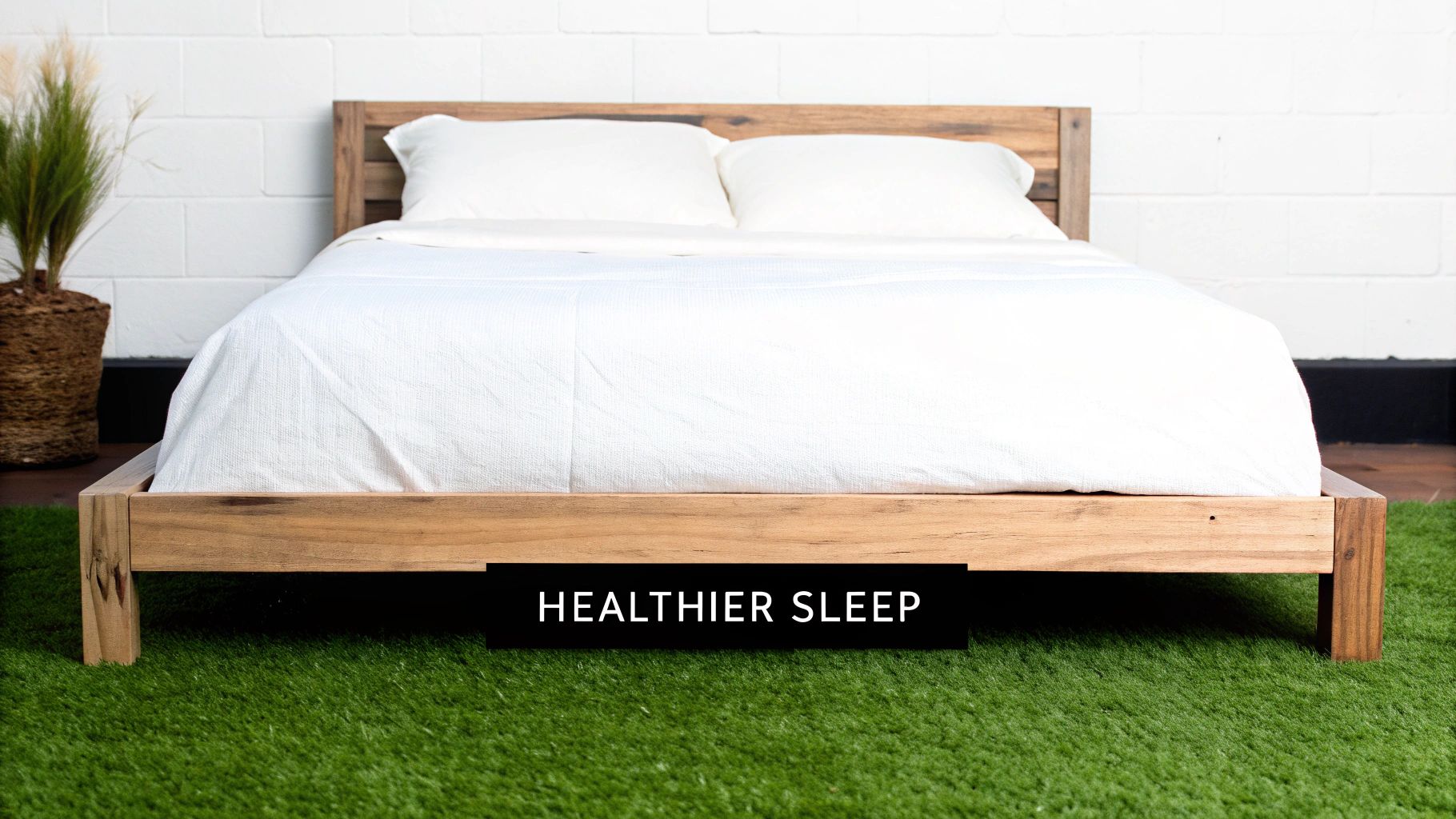
This shift towards healthier home goods is really gathering pace. As people become more aware of what goes into their products, they're actively seeking out organic bedding made from materials like certified organic cotton and linen. The global organic bedding market was valued at over USD 531 million in 2024 and is expected to nearly double by 2033, which shows how much families value these benefits. This is especially true here in the UK, where savvy shoppers are looking for products made without synthetic pesticides or chemicals. You can learn more in the full organic bedding market report.
A Healthier Choice for Your Family
Did you know conventional bedding can be made using a wide range of chemicals? From pesticides on the farm to harsh dyes and finishing agents in the factory, traces of these substances can linger in the final product. Your skin is in direct contact with your sheets for hours every night, and this prolonged exposure can sometimes lead to irritation, particularly for those with sensitive skin.
Organic bed linens provide a beautifully simple alternative. They are made from fibres grown without synthetic pesticides or fertilisers and are processed using much gentler, non-toxic methods. This makes them a wonderfully safe choice for everyone in the family.
- Kinder to Sensitive Skin: With no harsh chemical residues, organic fabrics are far less likely to trigger skin irritation, eczema, or allergies.
- Perfect for Children: A child’s skin is naturally more delicate. Wrapping them in pure organic bedding offers complete peace of mind.
- A Breath of Fresh Air: You can rest easy knowing your bedroom is a clean and healthy space, free from the unwanted chemicals often found in standard textiles.
Unbeatable Comfort Every Night
Beyond the health advantages, organic bed linens offer a level of comfort that is simply in a class of its own. Natural fibres like organic cotton have a structure that synthetic materials just can’t copy. They are naturally soft, exceptionally durable, and incredibly breathable.
This breathability is the secret to a more restful night's sleep. Organic cotton sheets allow air to circulate freely around your body, which helps regulate your temperature naturally. This means you stay comfortably cool on warm summer evenings and perfectly cosy on chilly winter nights.
Imagine slipping into sheets that feel impossibly soft and pure against your skin, helping your body find its perfect temperature for deep, uninterrupted sleep. That is the everyday luxury that organic bed linens bring to your home.
A Decision You Can Feel Good About
Finally, choosing organic is a thoughtful way to reduce your environmental footprint. Conventional cotton farming is known for its heavy reliance on water and chemical pesticides, which can damage soil, pollute waterways, and harm local wildlife.
Organic farming, on the other hand, works in harmony with nature. It uses methods that build healthy soil, conserve precious water, and promote biodiversity. By choosing organic, you are directly supporting a more sustainable system that is kinder to the planet and the farming communities who grow the fibres. It’s a small change in your home that contributes to a much bigger, positive impact.
A Guide to Organic Bed Linen Materials
Choosing the right organic bed linen is a wonderfully personal decision. It’s less about technical details and more about how you want to feel when you slip into bed at the end of the day. Do you love the crisp, cool feel of a luxury hotel bed, or do you prefer to be cocooned in silky, soft warmth?
Let’s walk through the most popular organic materials. We’ll focus on the feel of each fabric and what makes it special, so you can picture which one would create your perfect sleep sanctuary.
The Timeless Comfort of Organic Cotton
There’s a good reason organic cotton is the go-to choice for so many people. It’s durable, incredibly soft, and wonderfully versatile. The real magic is in the weave, which completely transforms how the cotton feels against your skin.
You’ll mainly find two types: percale and sateen. Each offers a completely different experience.
Organic Cotton Percale: The Crisp, Cool Choice
If your idea of heaven is sliding into a freshly made bed with cool, crisp sheets, then percale is for you. It’s made with a simple one-thread-over, one-thread-under weave that creates a light, breathable fabric with a lovely matte finish.
- How it Feels: Think of that classic, high-end hotel sheet. It’s light, airy, and has a refreshing crispness that only gets softer with every wash.
- Best For: Hot sleepers or anyone in a warmer climate. Its breathability is fantastic for keeping you cool and comfortable all night.
- Why You’ll Love It: Percale is incredibly durable and resistant to pilling, making it a brilliant, long-lasting investment for your home.
Organic Cotton Sateen: The Silky, Smooth Indulgence
For those who crave a touch of luxury and a silkier touch, sateen is a beautiful choice. It uses a different weave, typically one thread under and three or four over, which exposes more of the thread’s surface. This is what gives sateen its signature lustre and buttery, soft feel.
- How it Feels: Exceptionally soft with a subtle sheen that drapes beautifully. It feels smooth and luxurious against the skin.
- Best For: Anyone seeking extra warmth and a cosy, enveloping feel. It’s a perfect companion for the colder months.
- Why You’ll Love It: Sateen is naturally wrinkle-resistant, so it looks effortlessly elegant straight from the dryer.
The choice between percale and sateen really comes down to what you prefer. Are you dreaming of crisp, cool comfort or a silky, warm indulgence? There’s no wrong answer, only what feels best to you.
The Effortless Charm of Organic Linen
Organic linen, woven from the fibres of the flax plant, has a unique and timeless appeal. It's celebrated for its incredible durability and that relaxed, "lived-in" elegance. A true investment, linen only gets better and softer with age, often becoming a cherished family heirloom.
Linen is also one of the most sustainable fibres you can choose. The flax plant needs far less water than conventional cotton and is naturally pest-resistant, which means it can be grown without harsh chemicals.
Its natural texture and effortless drape bring a sense of rustic sophistication to any bedroom.
- How it Feels: Linen has a distinct, lightly textured feel that’s both breathable and absorbent. It starts with a pleasant crispness but quickly softens into a wonderfully supple fabric.
- Best For: Every season. Linen is a natural temperature regulator, keeping you cool in summer and cosy in winter. It’s perhaps the most versatile bedding material of all.
- Why You’ll Love It: It’s naturally hypoallergenic and brilliant at wicking moisture away from the body, ensuring a comfortable and dry night’s sleep.
Choosing the right fabric is a huge part of creating your perfect bed. To explore the options in more detail, take a look at our guide to the best bed sheets material for more helpful insights.
The Silky Softness of Organic Bamboo
Another wonderful material making a name for itself is organic bamboo. Sheets made from bamboo viscose feel incredibly luxurious, often compared to a blend of silk and cashmere. They are exceptionally soft, smooth, and have a beautiful, fluid drape that looks stunning.
As a resource, bamboo is a sustainability champion. It’s a fast-growing grass that requires very little water and no pesticides to thrive. When processed responsibly, it creates a fabric that’s as kind to the planet as it is to your skin.
- How it Feels: Incredibly soft and silky, with a luxurious drape that feels gentle and soothing.
- Best For: Those with sensitive skin or allergies. Bamboo fabric is naturally hypoallergenic and antibacterial.
- Why You’ll Love It: Its fantastic moisture-wicking and temperature-regulating properties make it a brilliant choice for year-round comfort.
Ultimately, the best organic bed linen is the one that calls to you, inviting you to relax and unwind the moment you see it. It’s about turning your bed into a true sanctuary.
How to Read Bedding Labels and Certifications
Walking down the bedding aisle can feel a bit overwhelming, with symbols and logos on every package. Learning to read these labels is the key to choosing genuinely organic bed linens with confidence. Think of them as a trustworthy promise, assuring you that what you’re bringing home is pure, safe, and made with integrity.
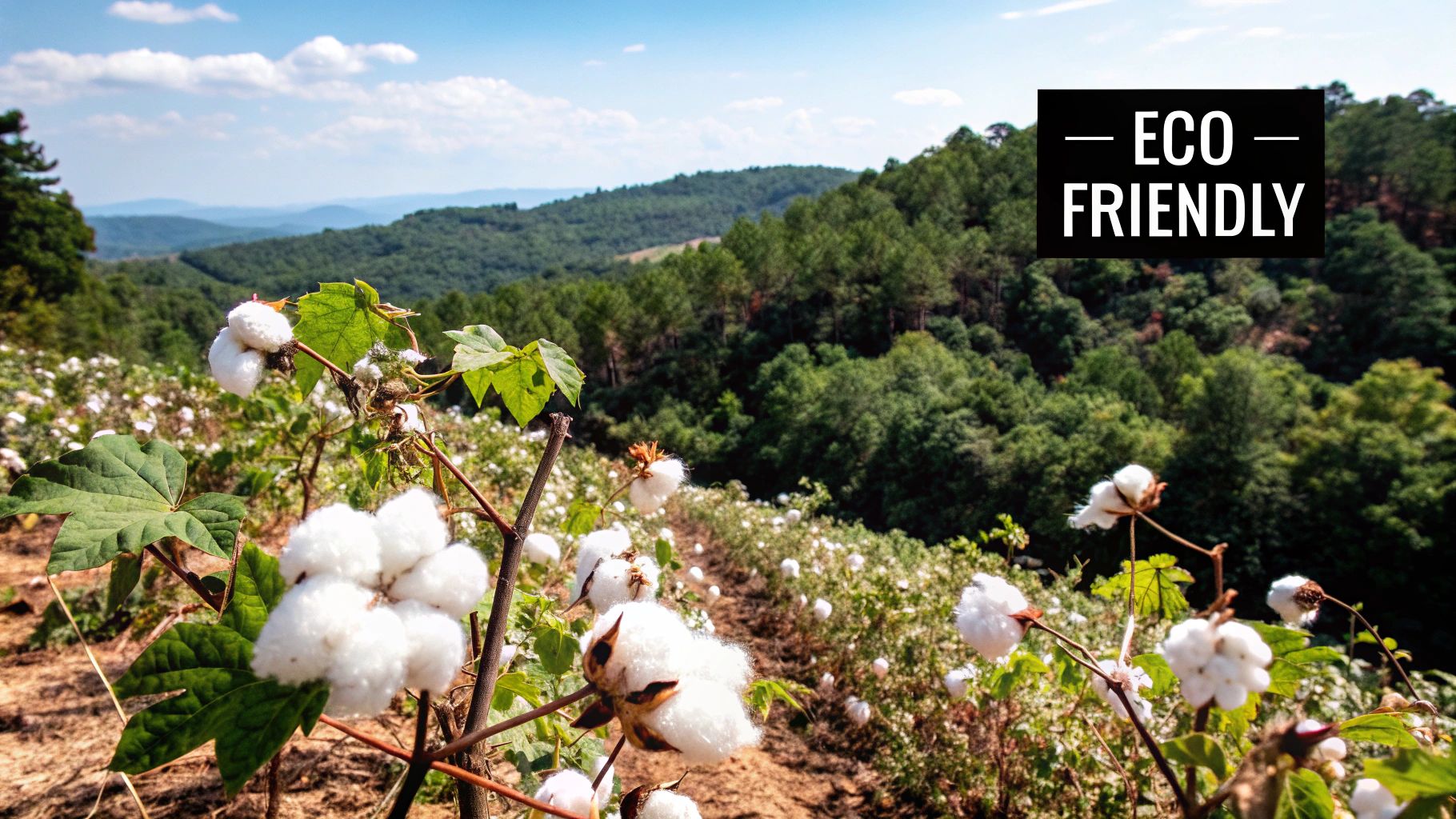
This guide will help you understand the most important certifications you’ll find in the UK and European market. We'll focus on the gold standard for organic textiles, showing you exactly what to look for so you can feel good about what you’re sleeping on.
Understanding GOTS: The Gold Standard for Organic Textiles
When you’re looking for truly organic bed linens, the one label that really matters is the Global Organic Textile Standard (GOTS). It’s the most respected and rigorous certification in the world for organic fibres, and it guarantees authenticity from the first seed to the final stitch.
A GOTS label means the product contains at least 70% certified organic natural fibres. More importantly, it looks beyond the farm, covering the entire journey from field to finished product. This includes everything from how the fibres are spun and woven to the dyes and even the packaging.
For a product to earn this certification, it must meet incredibly strict criteria.
- Environmental Standards: All dyes and processing chemicals must be non-toxic and biodegradable. Manufacturers are also required to have proper wastewater treatment systems in place.
- Social Responsibility: The certification ensures that everyone involved in production works in safe conditions and earns a fair wage, with an absolute ban on child labour.
In short, seeing the GOTS logo means you can trust that your bedding is authentically organic, environmentally friendly, and ethically made. It’s complete quality assurance that lets you sleep soundly in every sense of the word.
What Is OEKO-TEX?
Another label you'll often see is OEKO-TEX. While it’s an excellent certification for safety, it’s important to understand how it differs from GOTS. OEKO-TEX focuses on one thing, testing the final product for harmful substances.
If your bedding has the STANDARD 100 by OEKO-TEX label, it means every single component, from the thread to the buttons, has been tested and found to be free from a long list of chemicals known to be harmful to your health. It’s a fantastic mark of quality and safety.
However, OEKO-TEX does not certify a product as organic. The raw materials, like cotton, might have been grown conventionally using pesticides. So, while an OEKO-TEX certified product is safe for your skin, it doesn’t carry the same environmental or social guarantees as a GOTS-certified product.
Comparing Key Certifications
To make it even clearer, here's a simple breakdown of what these two key labels really mean for your organic bed linens.
| Certification | What It Guarantees | Organic Status |
|---|---|---|
| GOTS | The entire production process is organic, eco-friendly, and socially responsible. | Yes, confirms the item is truly organic. |
| OEKO-TEX | The finished product is tested and proven to be free from harmful substances. | No, does not certify the fibres are organic. |
So, what should you look for? For the ultimate peace of mind, a product that is both GOTS and OEKO-TEX certified is the best of both worlds. This tells you the bedding is made from organic fibres, processed sustainably and ethically, and has been independently verified as safe from harmful chemicals. It’s the clearest sign that you’re investing in the highest quality for your home.
A Practical Guide to Buying Organic Linens
Alright, now that we've covered the different materials and what those certifications really mean, it's time for the fun part. Let's choose the perfect organic bed linens for your home. This is where your new knowledge helps you make a confident choice, selecting pieces you'll adore for years to come.
You’re not alone in making this choice. The UK bed linen market was valued at around USD 1,820 million in 2024, and it's set to grow significantly. This shift is being driven by people just like you, seeking higher-quality, more sustainable pieces for their homes. For a deeper dive, you can explore the full UK bed linen market report.
Looking Beyond Thread Count
For years, we’ve been taught that a higher thread count equals better sheets. It's one of the biggest myths in the bedding industry. In reality, thread count is simply the number of threads woven into one square inch of fabric. While it offers a hint about the fabric's density, it's certainly not the whole story.
The quality of the fibre itself is what truly matters. Think of it this way: a sheet made from high-quality, long-staple organic cotton with a 300 thread count will feel far softer and prove much more durable than a sheet with a 1,000 thread count made from short, brittle fibres. So, instead of getting hung up on numbers, focus on the quality of the cotton and the type of weave, like a crisp percale or a silky sateen.
A truly luxurious feel comes from the quality of the raw materials and the craftsmanship of the weave, not just a high number on the packaging. Choose quality fibres over a high thread count for lasting softness.
This visual breakdown shows the benefits of choosing organic cotton, highlighting the crucial differences in water usage, pesticide reliance, and even how long the product lasts.
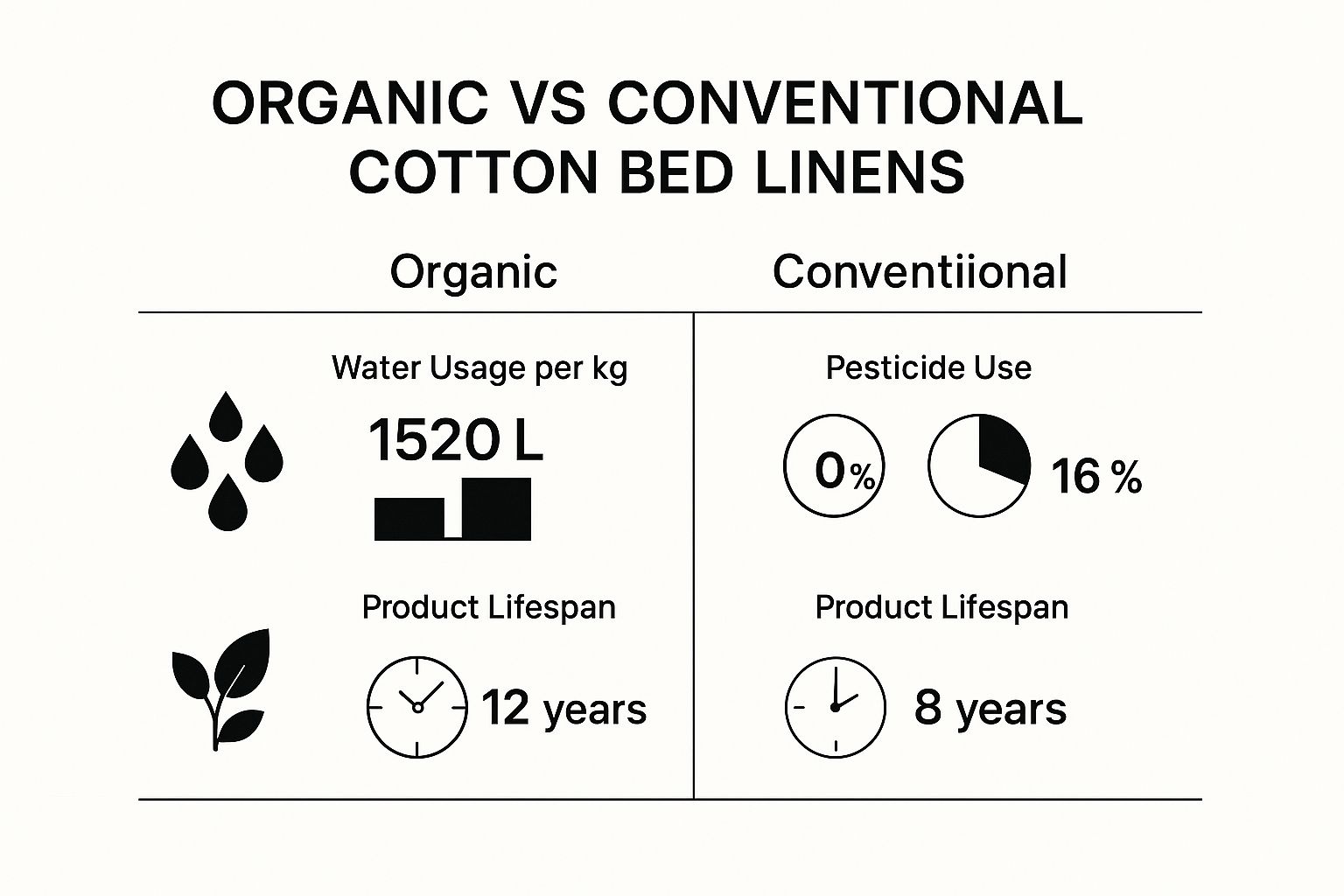
As the data shows, organic production isn't just better for the planet; it results in a more sustainable and durable product, making it a smarter investment all around.
Choosing the Right Size and Style
Getting the size right is absolutely crucial for a beautifully made bed. There's nothing more frustrating than a fitted sheet that constantly pings off the corners or a duvet cover that leaves your duvet swimming inside. Before you even start browsing, make sure to measure your mattress depth, length, and width.
It's a simple step, but one that makes all the difference. If you need a hand with the numbers, our guide on king size bedsheet dimensions in cm has some very useful tips.
With the practical details sorted, you can turn your attention to style. Your bedding is a wonderful opportunity to express your personality and set the tone for your entire bedroom.
- For a calm and serene retreat: You can't go wrong with soft, neutral colours like white, cream, or gentle earth tones. These shades create a peaceful atmosphere that’s perfect for unwinding.
- For a touch of modern elegance: Consider a classic pattern, like a simple stripe or a subtle geometric design. It adds a bit of visual interest without overwhelming the space.
- For a bold statement: Why not make your bed the star of the show? Rich, deep colours or a vibrant print can turn it into a stunning focal point.
Making a Lasting Investment
To help you find your perfect match, here's a quick comparison to help you select the best organic fabric based on your personal comfort and practical needs.
Choosing Your Perfect Organic Bed Linen
| Material | Feel & Texture | Best For | Key Benefit |
|---|---|---|---|
| Organic Cotton | Soft, breathable, and versatile. Crisp percale or silky sateen. | Everyday comfort and families. | A durable and classic choice that is easy to care for. |
| Organic Linen | Uniquely textured, airy, and effortlessly relaxed. | All-season comfort and a timeless, elegant look. | Gets softer with every wash and is exceptionally long-lasting. |
| Organic Bamboo | Incredibly smooth, silky, and drapes beautifully. | Sensitive skin and those seeking a touch of luxury. | Naturally hypoallergenic and brilliant at regulating temperature. |
By thinking about the feel of the fabric, getting the size spot-on, and choosing a style that brings you joy, you’re doing more than just buying new sheets. You’re investing in better sleep and creating a bedroom sanctuary you’ll look forward to retreating to every single night.
How to Care for Your Organic Linens
You’ve invested in beautiful organic bed linens, and with the right care, you’ll be rewarded with years of comfort. Looking after these natural fabrics isn’t complicated at all. In fact, a gentle touch is all it takes to keep them feeling soft, fresh, and utterly inviting.
These simple tips will help you preserve the natural integrity of your organic cotton, linen, or bamboo bedding, making sure every night feels as luxurious as the first.
Simple Washing for Lasting Softness
The secret to washing organic linens is to treat them kindly. Natural fibres thrive when they are not subjected to harsh temperatures or chemicals, which helps maintain their strength and softness.
- Choose a Cool Wash: Stick to a cool or warm cycle, somewhere around 30 to 40 degrees Celsius. High heat can cause the fibres to shrink and weaken over time.
- Use a Gentle Detergent: Opt for a mild, eco-friendly detergent. Aggressive chemicals can strip the fabric of its natural softness and leave behind residues that might irritate sensitive skin.
- Wash with Similar Items: To avoid unnecessary friction, wash your linens with items of a similar colour and weight. Tossing them in with heavy towels is not a good idea.
Drying Your Linens Naturally
How you dry your organic linens is just as crucial as how you wash them. Unsurprisingly, the most natural method is always the best.
Line drying is the gold standard here. It's incredibly gentle on the fabric, saves energy, and gives your sheets a crisp, natural freshness that a machine just can't match. If you must use a tumble dryer, select a low heat setting and pull the linens out while they’re still slightly damp. This helps prevent over-drying and minimises wrinkles.
For a perfectly smooth, iron-free finish, try this trick: make your bed while the linens are still faintly damp. As they air-dry completely, any remaining creases will naturally fall away, leaving them looking pristine.
Proper care is the key to extending the life of any premium bedding. For more tips on keeping that five-star hotel feel, take a look at our guide to maintaining your luxurious bed linens.
Storing for Freshness
When it's time to put away your spare sets, ensure they are completely dry to prevent any hint of mustiness from developing. Store them in a cool, dry, and well-ventilated space, like a linen cupboard, and keep them away from direct sunlight which can cause the colours to fade.
Here's a lovely little tip for staying organised: store each complete set inside one of its own pillowcases. It keeps everything bundled together, neat, and ready to use.
Still Have Questions About Organic Bedding?
It’s completely normal to have a few questions floating around after taking in all this information. To help clear up any lingering doubts, we’ve put together some of the most common queries we hear about organic bed linens.
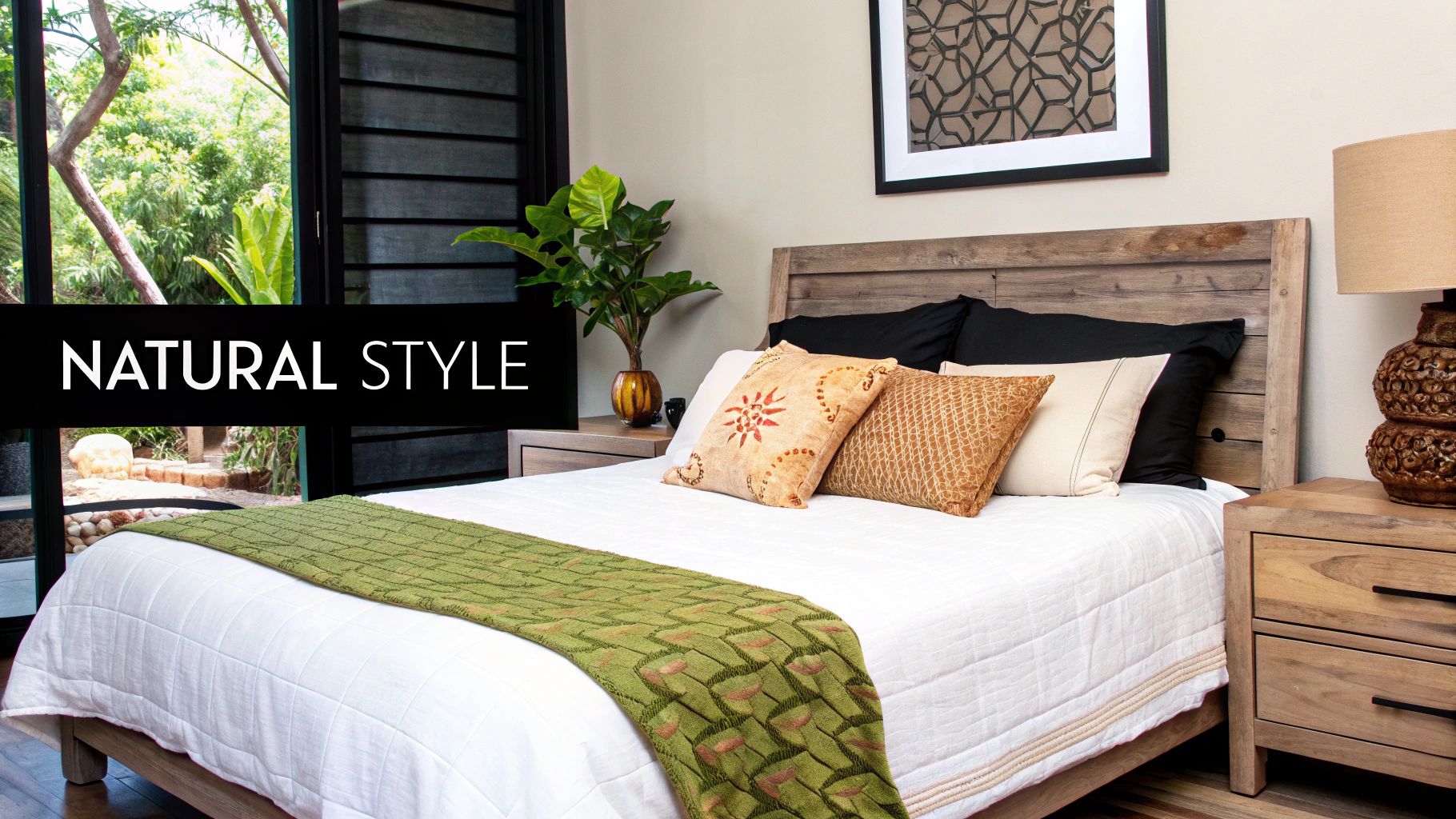
Think of this as the final piece of the puzzle, designed to give you total confidence as you begin your journey to a better, more comfortable night’s sleep.
Are Organic Bed Linens Really Worth the Extra Cost?
Let's be upfront, organic bed linens often have a higher price tag than their conventional counterparts. This reflects a commitment to higher quality materials and more thoughtful farming and manufacturing from the very beginning.
It’s probably more helpful to view it as a long-term investment in your wellbeing. Because of the superior natural fibres and careful craftsmanship, organic linens are far more durable and will outlast cheaper alternatives. They also bring wonderful health benefits, particularly if you or your family have sensitive skin.
So, while the initial spend might be a bit more, the lasting comfort, impressive durability, and peace of mind they deliver make them an exceptionally worthwhile choice for any home.
How Can I Tell if My Bedding is Genuinely Organic?
This is a fantastic question, and thankfully, the answer is quite straightforward. You need to look for the certification. The most reliable and globally recognised seal of approval is the Global Organic Textile Standard (GOTS) logo.
Spotting the GOTS label is your assurance that the product is the real deal, covering everything from the seed in the ground to the final stitch. It's a guarantee that the bedding meets incredibly strict standards, including:
- Organic Fibre Content: The product must contain a minimum of 70% certified organic fibres.
- Eco-Friendly Processing: All processes are free from harmful chemicals like toxic dyes and formaldehyde.
- Ethical Production: It ensures fair treatment and safe working conditions for everyone in the supply chain.
When you see that label, you can rest easy knowing you're bringing home an authentically organic product.
Choosing certified organic bed linens isn’t just about buying a product. It's about investing in a healthier sleep environment, supporting sustainable farming, and enjoying a quality that lasts. It’s a decision that brings comfort and peace of mind in equal measure.
Ready to transform your sleep into a truly restorative experience? Discover the pure comfort and modern style of Morgan and Reid’s collections. Explore our range of luxurious comforters and bedding today.


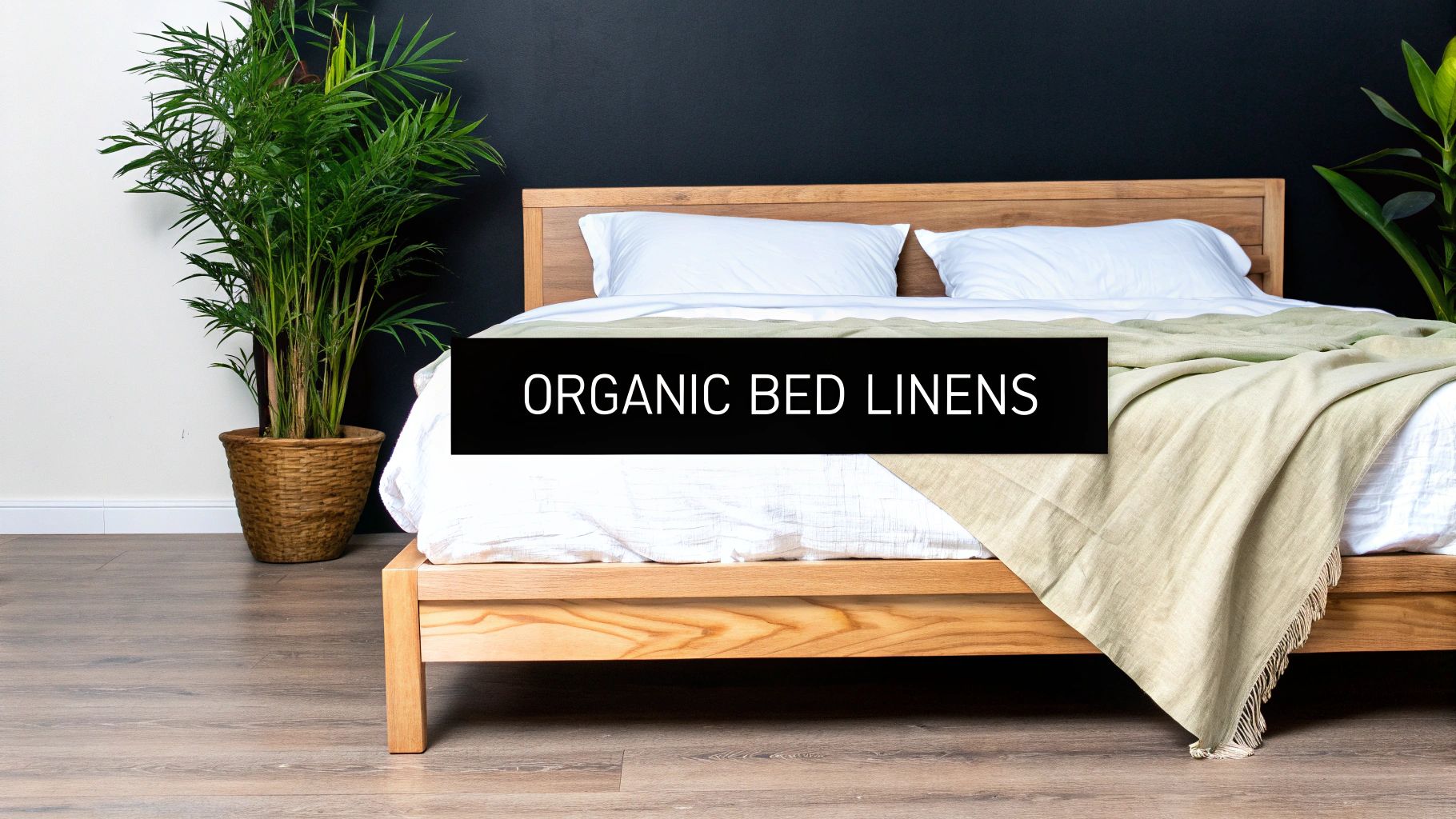
Share:
What’s the Best Thread Count for Sheets? (The Truth Every Aussie Should Know)
What Is a Pillow Sham? A Guide to Stylish Bedding